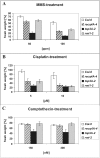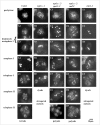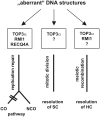Topoisomerase 3alpha and RMI1 suppress somatic crossovers and are essential for resolution of meiotic recombination intermediates in Arabidopsis thaliana
- PMID: 19096507
- PMCID: PMC2588661
- DOI: 10.1371/journal.pgen.1000285
Topoisomerase 3alpha and RMI1 suppress somatic crossovers and are essential for resolution of meiotic recombination intermediates in Arabidopsis thaliana
Abstract
Topoisomerases are enzymes with crucial functions in DNA metabolism. They are ubiquitously present in prokaryotes and eukaryotes and modify the steady-state level of DNA supercoiling. Biochemical analyses indicate that Topoisomerase 3alpha (TOP3alpha) functions together with a RecQ DNA helicase and a third partner, RMI1/BLAP75, in the resolution step of homologous recombination in a process called Holliday Junction dissolution in eukaryotes. Apart from that, little is known about the role of TOP3alpha in higher eukaryotes, as knockout mutants show early lethality or strong developmental defects. Using a hypomorphic insertion mutant of Arabidopsis thaliana (top3alpha-2), which is viable but completely sterile, we were able to define three different functions of the protein in mitosis and meiosis. The top3alpha-2 line exhibits fragmented chromosomes during mitosis and sensitivity to camptothecin, suggesting an important role in chromosome segregation partly overlapping with that of type IB topoisomerases. Furthermore, AtTOP3alpha, together with AtRECQ4A and AtRMI1, is involved in the suppression of crossover recombination in somatic cells as well as DNA repair in both mammals and A. thaliana. Surprisingly, AtTOP3alpha is also essential for meiosis. The phenotype of chromosome fragmentation, bridges, and telophase I arrest can be suppressed by AtSPO11 and AtRAD51 mutations, indicating that the protein is required for the resolution of recombination intermediates. As Atrmi1 mutants have a similar meiotic phenotype to Attop3alpha mutants, both proteins seem to be involved in a mechanism safeguarding the entangling of homologous chromosomes during meiosis. The requirement of AtTOP3alpha and AtRMI1 in a late step of meiotic recombination strongly hints at the possibility that the dissolution of double Holliday Junctions via a hemicatenane intermediate is indeed an indispensable step of meiotic recombination.
Conflict of interest statement
The authors have declared that no competing interests exist.
Figures







Similar articles
-
Different functional roles of RTR complex factors in DNA repair and meiosis in Arabidopsis and tomato.Plant J. 2021 May;106(4):965-977. doi: 10.1111/tpj.15211. Epub 2021 Mar 25. Plant J. 2021. PMID: 33619799
-
The Arabidopsis BLAP75/Rmi1 homologue plays crucial roles in meiotic double-strand break repair.PLoS Genet. 2008 Dec;4(12):e1000309. doi: 10.1371/journal.pgen.1000309. Epub 2008 Dec 19. PLoS Genet. 2008. PMID: 19096505 Free PMC article.
-
Different functions for the domains of the Arabidopsis thaliana RMI1 protein in DNA cross-link repair, somatic and meiotic recombination.Nucleic Acids Res. 2013 Nov;41(20):9349-60. doi: 10.1093/nar/gkt730. Epub 2013 Aug 16. Nucleic Acids Res. 2013. PMID: 23956219 Free PMC article.
-
The RTR complex as caretaker of genome stability and its unique meiotic function in plants.Front Plant Sci. 2014 Feb 12;5:33. doi: 10.3389/fpls.2014.00033. eCollection 2014. Front Plant Sci. 2014. PMID: 24575106 Free PMC article. Review.
-
The role of DNA helicases and their interaction partners in genome stability and meiotic recombination in plants.J Exp Bot. 2011 Mar;62(5):1565-79. doi: 10.1093/jxb/erq357. Epub 2010 Nov 16. J Exp Bot. 2011. PMID: 21081662 Review.
Cited by
-
DNA double-strand breaks and telomeres play important roles in trypanosoma brucei antigenic variation.Eukaryot Cell. 2015 Mar;14(3):196-205. doi: 10.1128/EC.00207-14. Epub 2015 Jan 9. Eukaryot Cell. 2015. PMID: 25576484 Free PMC article. Review.
-
The many lives of type IA topoisomerases.J Biol Chem. 2020 May 15;295(20):7138-7153. doi: 10.1074/jbc.REV120.008286. Epub 2020 Apr 10. J Biol Chem. 2020. PMID: 32277049 Free PMC article. Review.
-
AtGEN1 and AtSEND1, two paralogs in Arabidopsis, possess holliday junction resolvase activity.Plant Physiol. 2014 Sep;166(1):202-16. doi: 10.1104/pp.114.237834. Epub 2014 Jul 18. Plant Physiol. 2014. PMID: 25037209 Free PMC article.
-
Genome-wide analysis of heteroduplex DNA in mismatch repair-deficient yeast cells reveals novel properties of meiotic recombination pathways.PLoS Genet. 2011 Sep;7(9):e1002305. doi: 10.1371/journal.pgen.1002305. Epub 2011 Sep 29. PLoS Genet. 2011. PMID: 21980306 Free PMC article.
-
The dissolution of double Holliday junctions.Cold Spring Harb Perspect Biol. 2014 Jul 1;6(7):a016477. doi: 10.1101/cshperspect.a016477. Cold Spring Harb Perspect Biol. 2014. PMID: 24984776 Free PMC article. Review.
References
Publication types
MeSH terms
Substances
Associated data
- Actions
- Actions
LinkOut - more resources
Full Text Sources
Other Literature Sources
Molecular Biology Databases
Research Materials

